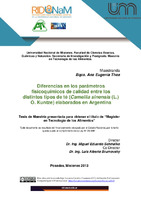Diferencias en los parámetros fisicoquímicos de calidad entre los distintos tipos de té (Camellia sinensis (L.) O. Kuntze elaborados en Argentina
Abstract
La producción nacional de té está constituida por alrededor del 3 % de té verde y té semifermentado y el resto por té negro y sus subproductos (denominados industrialmenteBT), teniendo como destino principal la exportación. La región tealera argentina se ubica en la zona noreste del país, en las provincias de Corrientes y Misiones, siendo la más austral del mundo. Muchos factores influyen en la composición química del té, y por lo tanto en su calidad; entre ellos, del área de producción, su clima, variedad implantada, las prácticas culturales y su manufactura. Debido a esto, la caracterización fisicoquímica de los tés de diversos orígenes es muy importante, teniendo en cuenta que estos estudios son muy escasos. Para determinar las diferencias en los parámetros fisicoquímicos de calidad de los distintos tipos de té elaborados en Argentina, se analizaron 51 muestras industriales de tés disponibles en el mercado incluyendo té negro (28), té verde (11), BT (11) y una de té semifermentado. Los ensayos realizados fueron: contenido de humedad, extracto acuoso, cenizas totales, cenizas insolubles en ácido, cafeína, fibra cruda, contenido de polifenoles totales (CPT), capacidad antioxidante (CAO) y los parámetros de color (L, ay b). Las muestras de té negro y té verde fueron las que presentaron mayores contenidos de
extracto acuoso (40,3 % bs y 40,7 % bs, respectivamente), mientras que las muestras de BT y el té semifermentado se caracterizaron por presentar un alto contenido de fibra cruda (20,4 % bs y 22,3 % bs, respectivamente). El contenido de cafeína fue superior en el té negro (2,7 % bs) respecto de los otros tipos de té estudiados. El té verde presentó los mayores contenidos de polifenoles totales y capacidad antioxidante (14,9 g equivalentes de ácido gálico/100 g de la materia seca y 30,0 g equivalentes de ácido ascórbico/100 g de la materia seca, respectivamente). Los resultados también pusieron en evidencia diferencias significativas (p < 0,05) en los parámetros de color entre los diferentes tipos de té. Argentinean tea production includes only an average of 3 % of green tea and semifermented tea, and the rest corresponds to black tea and black tea sub-product (BTSP) which is mainly sold to foreign markets. The production area is located in the northeast part of the country, in the provinces of Misiones and Corrientes, the southernmost region in the world. Many factors, such as geographical location, cultivar species, climate and agricultural and manufacture practices may influence the chemical composition of tea leaves, and therefore the tea quality. Because of these factors, the physicochemical characterization of teas from different origins is very important considering that these studies are currently scarce.
To determine differences in quality parameters between different types of tea elaborated in Argentina, moisture content, total ash, acid insoluble ash, water extract, crude fibre, caffeine, total polyphenol content, antioxidant activity, and colour parameters (L, a, b) were determined. Fifty-one industrial samples of commercially available teas including black tea (28), green tea (11), BTSP (11) and semifermented tea (1) were used for this study. Water extract contents were significantly higher in black tea and green tea (40.3 % and 40.7 % w/w, respectively), while semifermented tea and BTSP showed higher levels of crude fibre (22.3 % and 20.4 % w/w, respectively). Caffeine contents of black teas (2.7 % w/w) were significantly higher than in the other types of tea. Green teas revealed the highest concentrations of phenolic compounds and the major antioxidant activities (14.9 g gallic acid equivalents/100 g of the dry matter and 30.0 g ascorbic acid equivalents /100 g of the dry matter, respectively). The results also highlighted significant differences (p < 0.05) in colour values between the different types of tea.
Collections
- Maestría [55]
The following license files are associated with this item:




